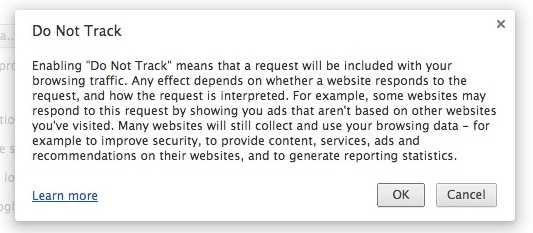How to Enable ‘Do Not Track’ in Chrome on the Mac or PC
![]() “Do Not Track” is an effort to increase privacy on the web, when enabled it sends a ‘do not track’ (DNT for short) request along with your web browsing, basically asking the web sites and services to not follow activity across the web. Because it’s entirely optional right now, not every website or service respects the DNT request, but for those who like added privacy on the web you can still opt-in to use the feature with most modern web browsers, which will pass along the DNT request anyway.
“Do Not Track” is an effort to increase privacy on the web, when enabled it sends a ‘do not track’ (DNT for short) request along with your web browsing, basically asking the web sites and services to not follow activity across the web. Because it’s entirely optional right now, not every website or service respects the DNT request, but for those who like added privacy on the web you can still opt-in to use the feature with most modern web browsers, which will pass along the DNT request anyway.
While many know that Safari has the feature on the Mac and for iOS too, but fewer people seem to know that modern versions of the popular Chrome web browser also supports Do Not Track request sending, which may interest some users and privacy buffs.
DNT is disabled in Chrome by default, but if you want to use the setting for the browser on your Mac (or Windows PC) you can enable it by going through Chrome Advanced Privacy settings as follows:
- Pull down the “Chrome” menu and choose “Preferences” (you can also go to chrome://settings/)
- Scroll to the bottom and click “Show advanced settings”
- Under the “Privacy” header, check the box for ‘Send a “Do Not Track” request with your browsing traffic’

Clicking the checkbox will bring about a message about Do Not Track that says the following, read it and click “OK” to enable the feature:
Enabling “Do Not Track” means that a request will be included with your browsing traffic. Any effect depends on whether a website responds to the request, and how the request is interpreted. For example, some websites may respond to this request by showing you ads that aren’t based on other websites you’ve visited. Many websites will still collect and use your browsing data – for example to improve security, to provide content, services, ads and recommendations on their websites, and to generate reporting statistics.

Click OK and go back to web browsing, that’s all there is to it, the Do Not Track header will now be sent along with your browsing traffic in Chrome. As mentioned already, this is simply a request and not every web service honors the request at the moment, but many individuals like to use it as a method of adding some privacy to their general web habits. It’s no replacement for clearing out browser history and cookies, or using a privacy feature like Private Browsing and Incognito Mode, but it can certainly be used as another utility in the broader online privacy toolbox.
Separately, Safari users can enable the Do Not Track feature in iOS on their iPhone and iPad, and with Safari for OS X on their Macs too.


Isn’t this just a request? Meaning, even with do not track turned on, won’t you still be tracked?
Yes correct, a Do Not Track request gets sent with your browsing. Some 3rd party services respect the request, others don’t. It’s not a standard yet.
Either way, it is definitely better than nothing. Thanks for the tip.
To be honest for privacy I’d use anything other than a google product.
I have it enabled, but since it’s optional it’s basically a feel-good measure until it becomes an adopted standard. So yea it probably stops a few ad targeting things, but ad targeting isn’t a big deal anyway, it’s the other Facebookstalky type stuff people find creepy.
For true privacy you have to use private browsing and start a new session every time. Dump caches and cookies once a day too. Use a VPN and/or proxy. Maybe even TOR if you’re really nutty about being James Bond.